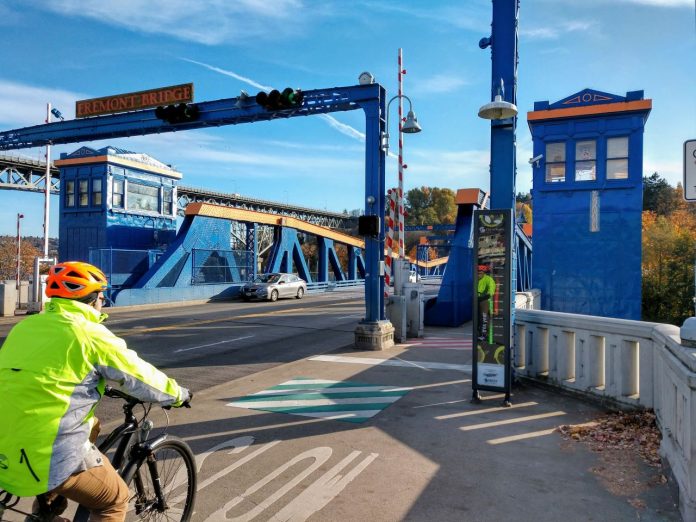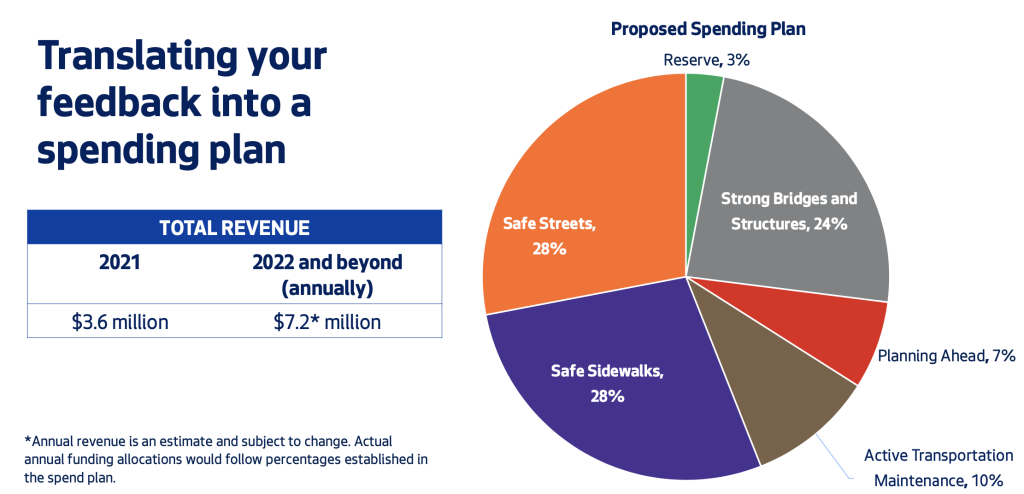
The Seattle City Council will vote today on the plan to invest $7.2 million in annual revenue from the $20 vehicle license fee (VLF) approved in November. On Wednesday, the transportation committee unanimously backed an amendment from Vice Chair Dan Strauss that reworded Committee Chair Alex Pedersen’s plan. The City Council is expected to approve the bill with the Strauss amendment today at its 2pm full council meeting (sign up for public testimony here).
Pedersen’s plan was laser-focused on bridge maintenance bonding, even if the exact bridges in question remained a moving target. Strauss’s plan keeps Council’s ask for the Seattle Department of Transportation (SDOT) to come up with a bridge maintenance project list tallying at least $75 million. However, his framing makes it much clearer than immediately bonding on 20 years of revenue from the VLF hike is not a foregone conclusion.
“We need to have a more accurate and detailed understanding of our maintenance and investments needs, and we need to use this information to raise the correct amount of bonds at the right time to invest in our infrastructure rather than taking on unneeded debt until we’re ready to use it,” Strauss said on Wednesday. “If this non-binding language was enacted on today, we would raise bonds without shovel-ready projects. This means we would be paying bankers interest on dollars we would not be ready to spend today.”
Councilmember Strauss’s amendment was fairly last minute and wasn’t available on the City’s website for the public to preview ahead of the 5-0 vote. Public comment at the start of the meeting had come down largely against Pedersen’s amendment, with several members of the Move All Seattle Sustainably (MASS) Coalition testifying, including Ryan Packer, senior editor at The Urbanist. “Ten people have lost their lives on our streets in the last four months,” Packer said. “This should be setting off alarm bells.”
MASS also issued a statement arguing for keeping SDOT’s spend plan which had dedicated 73% of revenue to safe streets, sidewalks, and multimodal planning and 24% to bridge structure maintenance, honoring the extensive stakeholder work that SDOT did. SDOT’s plan also included an equity analysis lacking in Pedersen’s plan.
While it had initially seemed significant that Strauss’s amendment won out over Pedersen’s, Mike Lindblom at the Seattle Times, seemed to argue the legislation hadn’t substantially changed and still signaled the same intent to bond for bridges. The lede of his article read: “A majority of Seattle City Council members declared their intent Wednesday to spend $75 million in future car-tab revenue to repair aging bridges, despite pushback from pedestrian advocates who said the plan shortchanges safety.”
Looking strictly at amendment language, the Strauss version could enable the same bridge-heavy plan as Pedersen has been fighting for since last fall. However, it’s clear the legislative intent is the same based on Councilmember comments. In particular, Councilmember Tammy Morales expressed an interest in safety projects and honoring SDOT’s plan.
Vice Chair Strauss’s comments meanwhile suggested he thought they were rushing into a bonding decision rather than letting specific project needs and timelines guide them. Perhaps having a bridge project list before him by September 30th will convince him the bridge maintenance costs and timelines make sense for bonding. However, given the high cost of significant bridge work, the list could also reveal that the $75 million doesn’t get the City very far and could only fund a couple bridge retrofits.
Back in November, Council President Lorena González authored the successful amendment that directed SDOT to do the outreach process to produce a VLF spending plan, which Pedersen then proceeded to overrule last month. The votes to pass the González amendment (instead of the all bridge maintenance plan backed by Pedersen, Andrew Lewis, and Lisa Herbold) came from Councilmembers Strauss, Morales, Teresa Mosqueda, and Kshama Sawant. If those five Councilmembers ultimately stick with the SDOT outreach process they authorized and the resulting spend plan, then Pedersen’s plan could still be sunk. However, Councilmember Mosqueda did initially sign on to Pedersen’s new 75% bridge maintenance plan and express a desire to bond to create jobs. So, much may hinge on her and Strauss’s ultimate vote. The actual bonding approval will require six votes, which could also come into play.
Doug Trumm is publisher of The Urbanist. An Urbanist writer since 2015, he dreams of pedestrian streets, bus lanes, and a mass-timber building spree to end our housing crisis. He graduated from the Evans School of Public Policy and Governance at the University of Washington in 2019. He lives in Seattle's Fremont neighborhood and loves to explore the city by foot and by bike.


